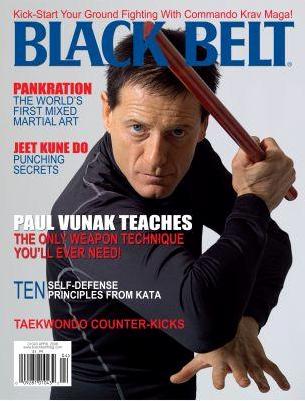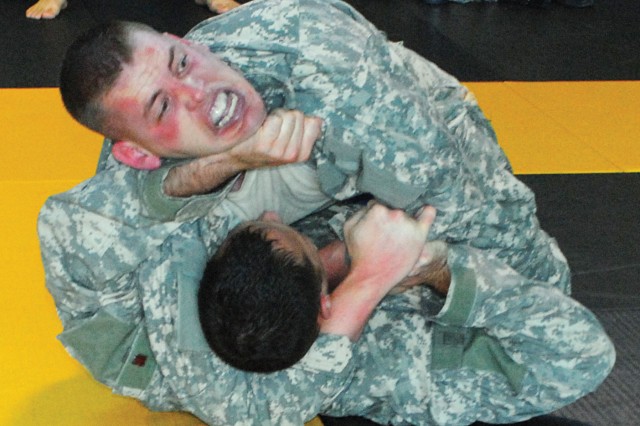The following is a reprint of my teacher Sigung
Paul Vunak's article in Black Belt Magazine Published April 2010. It describes his organization called
PFS (Progressive Fighting Systems) latest innovations in
practical fighting sciences and the new teaching methods he is requiring of an elite corps of hand-picked instructors.
- What are the origins or this self defense fighting method?
- Would Bruce Lee and Danny Inosanto be proud?
- What happens when you remove the rules from sport UFC MMA?
Source: http://Fighting.net Reprinted with permission. Direct link: http://fighting.net/main.php?page=filthymma
For more information, seminars or training in the Southwest, Arizona, New Mexico, Utah region Contact:
DOM Instructor John Nottingham: http://fighting.net/johnn with Sword & Shield Security.
Paul Vunak's Filthy MMA (Contemporary JKD)
In 1959 Bruce Lee came to America, at that time his original art was Wing-Chun. Over the next few years of working with much larger and stronger Americans, Bruce Lee discovered the limitations of Wing-Chun.
In 1964 at the Long Beach Internationals is where Bruce Lee first met Dan Inosanto. Inosanto at that time was a world class athlete running the 100 yard dash in 9.4 seconds. Over the next 9 years Bruce and Dan together created what is now known as Jeet Kune Do. They dissected and synthesized every art and philosophy salient to street fighting. In 1973 Bruce Lee passed away, and the mantle of Jeet Kune Do was officially passed to Dan Inosanto. In 1974 Mr. Inosanto opened the doors to the Filipino Kali Academy. His intention was and still is to continue to cultivate and refine the original process by which he and Bruce started.
3 years later in 1977 is when I personally joined the Kali Academy. From that very first day, I vividly remember Inosanto pounding in our heads, what he said was the most important principle in JKD. "Constant Growth and Progression". Indeed the very words on his certificate echo this principle of continual growth and progression.

"Change is necessary so the practitioner can adapt to the ever changing times and situations. "
The reason JKD was and is so affective lies in the simple fact that it is cutting edge. For example, during the mid 70's everyone used to kick above the waist only. The folks that were at the top of the heap in this world were PKA(Professional Karate Association). The raging paradigm at the time was, one would irreparably damage the knees if leg kicks were applied. We disagreed vehemently with that conclusion. Very few people knew anything about Thai boxing in those days. And this happened to be one of the last arts that Bruce and Dan were exploring before Bruce's death. Wanting to continue this exploration we invited Chai Siruste "World Champion Thai Boxer" to the Kali Academy. We all fell in love with Thai Boxing. The effectiveness of Thai boxing became so evident from that day on, that we made it a staple in the JKD curriculum. Throughout the rest of the 70's and into the early 80's while most of America was fighting out a low stance, and throwing face kicks. We were slamming our opponents front leg with the infamous Thai round kick, then clinching their necks and throwing elbows and knees Thai style. This curriculum served us well, right up until 1983 when we first met the Gracies.

My first experience with Rorion and Royce Gracie left me speechless, angry, and enamored. So I decided to train Jiu-Jitsu full time and became quite fanatical. A few years later Inosanto and Larry Hartsell both caught the bug. Not long after Dan Inosanto became Rigan Machado's oldest Black Belt.
[The Gracies, Machados, BJJ, and MMA]
By 1985 we made Brazilian Jiu-Jitsu an official part of our JKD curriculum. If one were a fly on the wall at the Filipino Kali Academy around these very years they would see during full contact sparring,-jabs, crosses, kicks, Thai clinching, elbows, knees, takedowns, arm locks, triangles and chokes. In other words it would look like what MMA looks like today. The conclusions that we discovered in JKD are the identical conclusions that the MMA world discovered. 95% of the actual techniques needed in one on one empty hand battles lye within two arts, Thai boxing and Brazilian jiu-jitsu. I use mix martial arts as an example, because the greatest fighters in the world have culminated to what is now known as mixed martial arts. The top of the heap in this game is the UFC. The UFC has sponsored just over "100" fight nights. There have been roughly 700 fights, of those there have been 432 victories.(268 went to a decision) 218 were from knockouts, of either punches, kicks, elbows or knees. Mostly Thai style. And mostly from the Thai clinch. We clearly have to give the majority of the standup techniques to the Thai's. There have also been 214 victories on the ground due to submissions. This means arm locks, leg locks, triangles, and chokes, these moves all belong to Brazilian jiu-jitsu(no one even know of any of these moves till Royce Gracie came along).
Additional Arts in contemporary JKD,
Once one has the foundation of Thai Boxing and Brazilian Jiu-JItsu. It always helps to spice up your game by throwing in other styles. Say Greco Roman for the Clinch, Wing-Chun to improve forward pressure, or perhaps Savate for some Cro-Cop like kicks. In 1989 we decided to investigate shooto fighting, Inosanto brought in Sensei Yuri Nakamuri, and much like the Thai boxing everyone fell in love with shoot fighting.
In 1993 Eric Paulson (In my opinion Dan's all time best student) won the Light Heaveyweight Shoot Fighting Championship of the world and solidified shoot fightings contribution in contemporary JKD.
Where does original JKD fit in ?
When we say original JKD we are referring to the combined curriculums of the Seattle, Oakland and LA Chinatown schools prior to Bruce Lee's death. We strongly believe that the original curriculum should be preserved and immortalized. In order to assure this for the past 25 years we have made it mandatory for all Phase 1 students to know the entire curriculum of original JKD. When I hear people asking which is better ? Comparing original jkd to contemporary jkd(which is commonly called JKD concepts) I have to smile and scratch my head. You see, original JKD is contained within contemporary JKD. It would be like asking which is better, a Jab or Boxing ? Since a Jab is contained within boxing, the question is moot. Another reason against comparing the two has to do with fairness to Bruce Lee. In order to even be competitive now adays, there are some simple pre-requisites one absolutely must have...
A clinch Game(Either the neck or the body)
Takedown defense,
A Ground game.
The reason that none of these elements are in original JKD. Is because they didn't even exist prior to the first UFC which was 20 years after Bruce Lee's death.
Taking JKD to the next level of violence.
 Paul Vunak and SEAL TEAM 6 - Virginia Beach,1987
Paul Vunak and SEAL TEAM 6 - Virginia Beach,1987
Once one has gone through the rigors of getting their thai boxing and brazilian jiu-jitsu as good as possible, then the only logical conclusion in order to progress is to cheat. The elements that serve us best in this cause are the weapons, stick and knife, and kina mutai. The Filipino Art of Un-Interruppted Biting and Eye Gouging. Regarding the weapons first, 76 % of altercations envolve weapons of some sort. We have gleaned these statistics from various FBI, DEA and police departments. In other words when a fight begins, the first visceral response someone has is to reach around them and grab something. This something can be a tire iron, a crow bar, a pocket knife a mag lite, a broken bottle, a pool cue etc... etc..
This means one could be a UFC champion, and go celebrating that night with the belt that they just won and perhaps confront some knuckle head, drunk, who pulls out a knife. Well there are absolutely, positively certain edged weapons principles that one must know or die. And the possibility of this world champion being a statistic is greater than one would think.
So as the JKD person is concerned with survival first, they augment their empty hands with Filipino Weaponry. In the world of combat as Bruce taught us that no one style, system or ethnicity has it all. And just as the Brazilians are experts on the ground, and the French are experts with their high kicks, it is the Filipinos that are cutting edge with all weapons. Therefore I highly recommend that you find a Kali or escrima school for this part of your game.
Kina Mutai - the Filipino Art of Biting and Eye Gouging.
The Main difference between a kinamutai bite and just a plain bite has to do with how, when and where they attack. When a kina mutai practitioner bites you, it is with an uninterrupted bite. Since he knows the exact places on the body to bite, and with precise timing. He grabs you with his incredible grip strength, rips into your flesh like a pit bull( using mainly one's k-nines) and the single most important thing is that you are in some sort of bear hug while this is happening. Every single bite or eye gouge performed by a kina mutai specialist is augmented with their right hand gripping their left wrist, or their left hand gripping their right wrist(in a bear hug type of fashion). The actual motion of the bite is a repeated circular ripping of the flesh ,when applied over a period of time the damage inflicted is unimaginable.
A contemporary JKD man escalates their level of violence to this degree only for two possible reasons.
- One is to protect their to family.(perhaps carjacking, home invasion, or child abductions etc)
- For a military operation.
In conclusion, please understand that my intention upon writing this article, "Contemporary JKD", is not to add yet another name for all of us to "fuss" over, I am however real big on respect. I believe out of respect to Bruce Lee and his direct original students, his original curriculum should be preserved and immortalized. I also believe that the people that have put forth 3 decades of sweat and blood, in order to keep Bruce's Art cutting edge also deserve respect, as we are all branches of the same tree.
If I had to describe contemporary JKD in a couple of words, You've heard of Dirty Boxing ? My couple of words are ... Filthy MMA.
About the Author:
Mr Vunak would like everyone to know about his program Adapt 4 Life, "teaching martial arts to physically challenged children". For more information go to www.fighting.net.
fighting.net/johnn







